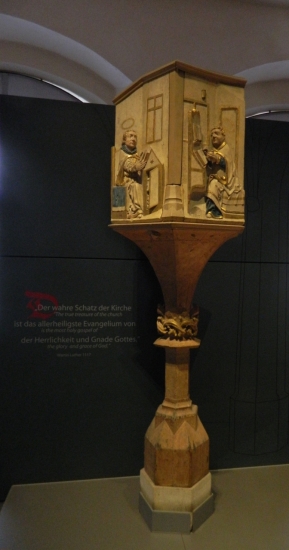Luther Visualized 16 – Busyness and Health
November 15, 2017 Leave a comment
Luther’s Busyness and Ill Health
The painting shows Luther preaching, of which he did plenty. From May 1528 to June 1529 and from October 1530 to April 1532, for example, the parish church’s regular pastor, Johannes Bugenhagen, was on leave introducing the Reformation in cities like Brunswick (Braunschweig), Hamburg, and Lübeck, and Luther had to take over his preaching duties in the meantime. Toward the end of 1531, Luther told his table companions, “I am extremely busy. Four people are relying on me, and each one of them was in need of someone all to him- or herself. I’m supposed to preach four times during the week, lecture twice, marriage cases need to be heard and letters need to be written, plus I’m supposed to work on books for publication.”

The pulpit from which Luther preached thousands of sermons in the Wittenberg parish church, today housed in the Lutherhaus museum in Wittenberg (© Red Brick Parsonage, 2013). The two reliefs are of the apostles and evangelists Matthew (left) and John (right).
Several details in the Cranach painting above merit further comment. The writing in Luther’s Bible is indistinct; regardless of his sermon text, he can and ought to point his audience to Jesus (John 5:39). The audience consists of people of every age; the gospel of Jesus is for all (Matthew 28:19,20; Mark 16:15; Luke 18:15-17). Cranach painted himself in the front of the male audience; he viewed the message of Christ crucified for sinners as one needed by him first (cf. 1 Timothy 1:15,16). Katy and little Hans Luther are in the front of the female audience; even the reformer’s son needed to be restrained and taught to stay still and listen. In spite of the fact that the great reformer himself is preaching, there are still some in the audience paying attention to the “picture-taker” and not to God’s Word. At his table in the evening of December 26, 1531, Luther told his companions, “My preaching is useless. It’s like a man who sings in a forest to the trees and hears only the glad-sounding echo in return.” And yet, as he went on to say, “although many people badmouth [gospel preaching], it is still good to preach Christ for the sake of the few who do not.”
In addition to the strain of his professional duties and callings as husband and father, Luther also suffered at various times from the following health issues:
- Periods of depression occasioned by personal doubts, disease and death in his circle of family and friends, disturbances in the church, and the other health problems in this list
- Constipation
- Hemorrhoids
- Ménière’s (pronounced mane-YAIRZ) disease
- Recurring dizzy and fainting spells (likely caused by the previous)
- Soreness in his teeth and throat
- Recurring kidney stones (the most famous instance in February 1537)
- Gallstones
- Abscess on the lower part of one of his legs
- Recurring colds
- Diarrhea
- Severe heart attack in December 1536
- Dysentery
- Abscess on his neck
- Recurring headaches toward the end of his life
- Gout
- Arthritis
- Loss of sight in one eye (cataract?)
- Exacerbation of health issues from ill-advised treatments
Luther had definitely abused his body earlier in his life with, for example, his excessive fasting in the monastery. His life then changed drastically when he got married and went from not taking good care of himself to eating regular homemade meals prepared by his wife—a change to which his body probably never completely adjusted. But ultimately, it was the Lord who used these recurring health issues to keep Luther from becoming conceited, to show him the all-sufficiency of his grace, and to demonstrate that his power is made perfect in weakness (cf. 2 Corinthians 12:7-9).
Sources
E. G. Schwiebert, Luther and His Times (St. Louis: Concordia Publishing House, 1950), pp. 580,581,748-750
Kurt K. Hendel, Johannes Bugenhagen: Selected Writings, vol. 1 (Minneapolis: Fortress Press, 2015), pp. 33-53
Martin Brecht, Martin Luther: Shaping and Defining the Reformation (Minneapolis: Fortress Press, 1990), pp. 204-211,429-433
Martin Brecht, Martin Luther: The Preservation of the Church (Minneapolis: Fortress Press, 1993), pp. 21-23,185-188,229-235
Weimarer Ausgabe, Tischreden 1:73, no. 154; 2:417-418, no. 2320
